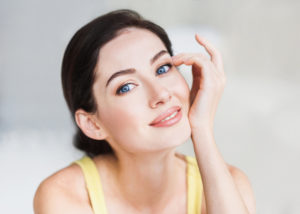
So, let’s give this second blog of a still-toasty September in Lewisville to more about Botox.
Where does Botox work its magic?
At Dr. Lipton’s we have patients who clump Botox together with dermal fillers such as Juvéderm and Restylane (both of which we offer), but they are actually completely different.
Dermal fillers are true to their name — when injected they “fill” in an area of volume loss that has created a wrinkle, crease, or sunken area. Natural fillers are made from hyaluronic acid, a naturally occurring substance in the human body that is responsible for plumping and firming the skin. When Juvéderm is injected beneath a crease, the hyaluronic acid binds with nearby water molecules, instantly plumping the area and pushing the skin back up. This only works on wrinkles that form on the mid to lower face. These are “static” wrinkles that show themselves at all times: smile lines, parentheses lines, barcode lines, marionette lines, sunken cheeks, tear troughs, and the like. Botox doesn’t work on static wrinkles.
As we discussed in this month’s first blog, Botox works on “dynamic” wrinkles that form on the surface skin due to muscle contractions beneath the skin. Because it is a neuromodulator made from the botulinum toxin, when Botox is injected into a muscle creating a wrinkle on the skin above, it temporarily stops the muscle from contracting, and this stops the wrinkle or crease from forming.
Botox works on the expressive area of the face, the upper third. Go ahead, squint or make a frown and you can feel the muscles engage. These form crow’s feet at the sides of the eyes, forehead lines, and the 11s between the eyebrows. Those are the areas where Botox reigns.
More than just a wrinkle eraser
A cool aspect of Botox is that it pulls double duty for many other purposes beyond erasing wrinkles. In fact, the first Botox FDA approval was for one of those — blepharospasm, otherwise known as involuntary eyelid spasms.
The medical uses of Botox keep expanding. Beyond wrinkles, Botox is now used to treat all these conditions:
- Involuntary eyelid spasms
- Hyperhidrosis (excessive underarm sweating)
- Upper limb spasticity
- Lower limb spasticity
- Cervical dystonia (neck spasms)
- Chronic migraine headache prevention
- Urinary incontinence
- Overactive bladder
- Temporomandibular joint disorder
That ends our September tribute to Botox at Dr. Lipton’s. Now that you’re an expert, is it time to erase those frown lines between your eyebrows? Call us at (972) 420-0023 to set up a Botox session with Dr. Lipton.

